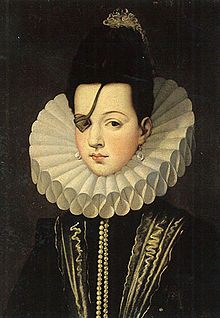Ana de Mendoza y de Silva, Princess of Éboli
The Princess of Eboli | |
|---|---|
 Ana de Mendoza, Princess of Éboli | |
| Full name | Ana de Mendoza y de la Cerda |
| Born | June 29, 1540 Cifuentes, Guadalajara, Spain |
| Died | February 2, 1592 (aged 51) Pastrana, Guadalajara, Spain |
| Noble family | House of Mendoza House of Silva |
| Spouse(s) | Ruy Gómez de Silva |
| Father | Diego Hurtado de Mendoza y de la Cerda |
| Mother | Catalina de Silva |
Ana de Mendoza y de la Cerda, Princess of Eboli, Duchess of Pastrana, (in full, Template:Lang-es), (29 June 1540 – 2 February 1592) was a Spanish aristocrat,[1] suo jure 2nd Princess of Mélito, 2nd Duchess of Francavilla and 3rd Countess of Aliano.
Early years
Ana, Countess of Melito and Duchess of Pastrana, married Rui Gomes da Silva, 1st Prince of Éboli when she was 13 years old (1553), by recommendation of the regent of Spain, the future King Philip II.[2] Her husband was a chief councillor and favourite with Philip, and from 1559 Prince of Éboli. Although she may have been blind in one eye, the Princess of Éboli was considered very attractive. She was an energetic person, and prominent in court life. One of her friends was the queen, Isabel de Valois.[3]
Ana, Princess of Éboli, had ten children by her marriage:[4]
- Diego (c.1558–1563)
- Ana de Silva y Mendoza (1560–1610) married 1572 to Alonso Pérez de Guzmán, 7th Duke of Medina Sidonia
- Rodrigo de Silva y Mendoza (1562–1596), 2nd duke of Pastrana
- Pedro de Silva y Mendoza (c. 1563)
- Diego de Silva y Mendoza (1564–1630), 1st marquis of Alenquer
- Ruy de Silva y Mendoza (1565–), 1st marquis of La Eliseda
- Fernando de Silva y Mendoza, later Pedro González de Mendoza (1570–1639)
- Maria de Mendoza y Maria de Silva (c. 1570)
- Ana de Silva y Mendoza (1573–1614)
Later intrigue
After her husband's death in 1573, she spent three years in a convent, but returned to public life in 1576, forming an alliance at Court with the King's undersecretary of state, Antonio Pérez (1540–1615).[5] They were accused of betraying state secrets which led to her arrest in 1579. Ana died 13 years later in prison on 2 February 1592.
Appearances in fiction
There was a character called Princess Eboli based on Ana in Schiller's play Don Carlos, Infant von Spanien, and Verdi's opera Don Carlos.[6] She is also the subject of Kate O'Brien's novel That Lady,[7] and the 1955 film adaptation of O'Brien's novel, That Lady. La Tuerta, a stage play charting the life of Ana de Mendoza was performed at Bedlam Theatre as part of The Edinburgh Fringe Festival in August 2008. Julia Ormond played her in La Conjura de El Escorial (2008) and Belén Rueda in the TV film La Princesa de Éboli (2010).
References
- ^ Henry Kamen (1999). Who's Who in Europe 1450–1750. Routledge (UK). ISBN 0-415-14727-1.
- ^ Henry Kamen: Philip of Spain. Yale University Press. 1998. ISBN 978-0-300-07800-8. pp. 85, 166.
- ^ Kamen, Philip of Spain: pp. 166, 342.
- ^ Kamen, Philip of Spain: pp. 166.
- ^ J. H. Elliott (2002). Imperial Spain, 1469–1716. Penguin Books. ISBN 0-14-100703-6.
- ^ Friedrich Schiller (2000). Don Carlos and Mary Stuart. Oxford University Press. ISBN 0-19-283985-3.
- ^ Kate O'Brien (1949). That Lady: A Romantic Drama. Harper.
